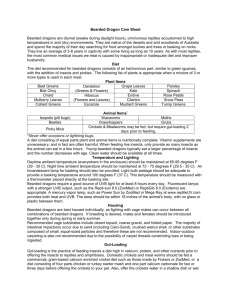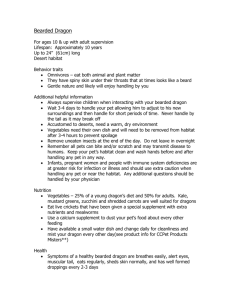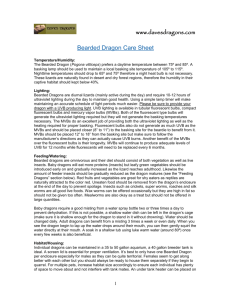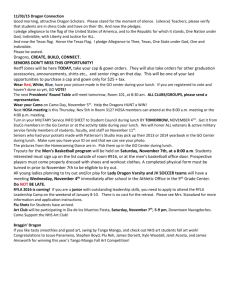In the Wild - The Maryland Zoo in Baltimore
advertisement
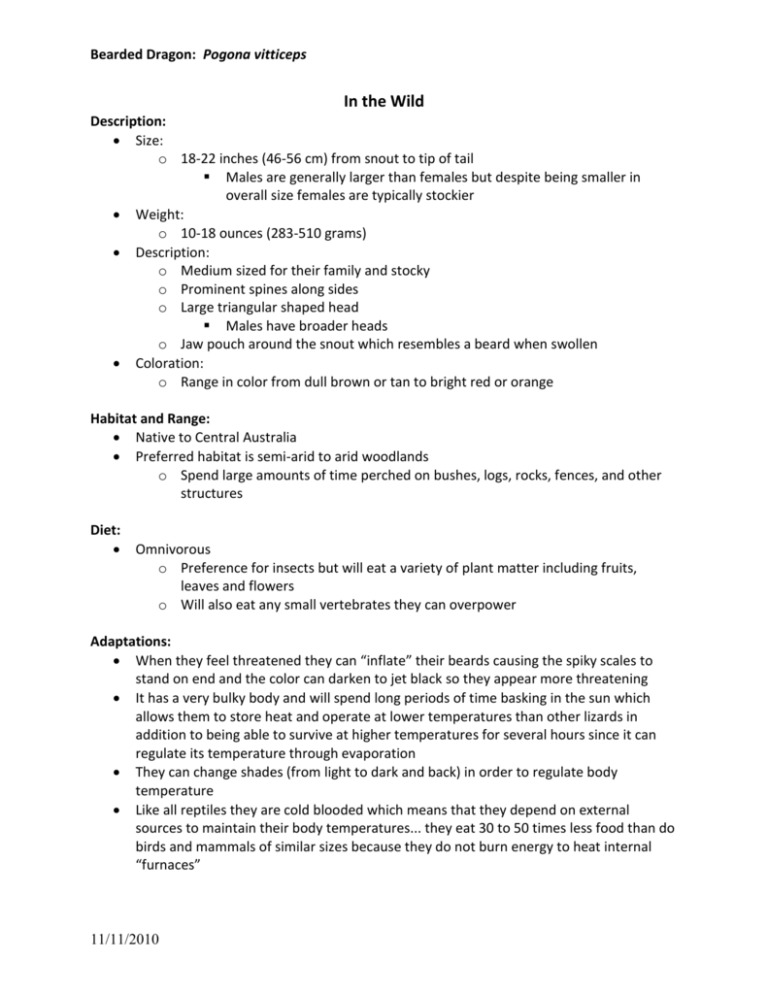
Bearded Dragon: Pogona vitticeps In the Wild Description: Size: o 18-22 inches (46-56 cm) from snout to tip of tail Males are generally larger than females but despite being smaller in overall size females are typically stockier Weight: o 10-18 ounces (283-510 grams) Description: o Medium sized for their family and stocky o Prominent spines along sides o Large triangular shaped head Males have broader heads o Jaw pouch around the snout which resembles a beard when swollen Coloration: o Range in color from dull brown or tan to bright red or orange Habitat and Range: Native to Central Australia Preferred habitat is semi-arid to arid woodlands o Spend large amounts of time perched on bushes, logs, rocks, fences, and other structures Diet: Omnivorous o Preference for insects but will eat a variety of plant matter including fruits, leaves and flowers o Will also eat any small vertebrates they can overpower Adaptations: When they feel threatened they can “inflate” their beards causing the spiky scales to stand on end and the color can darken to jet black so they appear more threatening It has a very bulky body and will spend long periods of time basking in the sun which allows them to store heat and operate at lower temperatures than other lizards in addition to being able to survive at higher temperatures for several hours since it can regulate its temperature through evaporation They can change shades (from light to dark and back) in order to regulate body temperature Like all reptiles they are cold blooded which means that they depend on external sources to maintain their body temperatures... they eat 30 to 50 times less food than do birds and mammals of similar sizes because they do not burn energy to heat internal “furnaces” 11/11/2010 Bearded Dragon: Pogona vitticeps Display a behavior akin to arm waving as they stand on three legs and wave one of their limbs in a slow circular pattern which is hypothesized to aid in species recognition and also as a show of submission They are opportunistic omnivores whose stomachs are large enough to accommodate large quantities of plant matter, insects, spiders, and the occasional small rodent or lizard allowing them to live in areas where food is hard to find Lifespan: Average lifespan of 4-10 years o Can live for as long as 15 years in captivity in zoos or as pets Ecosystem relationships: Adult bearded dragons are territorial and establish social hierarchies with aggressive displays a normal part of social interaction Reproduction: Reach sexual maturity at 1-2 years of age Mating occurs in warm summer months o Australia’s September-March o Captive individuals do not appear to display seasonal breeding habits and will mate year round During mating males mount females and bite the side of their neck Females will dig a burrow in which they lay their eggs o Up to 24 eggs per clutch o Up to 9 clutches laid per year o Eggs are 0.7-1 inch in length and have parchment-like shells Females are known to be able to store sperm and so they are able to lay multiple clutches of fertile eggs from one mating Incubation is 70 days and hatchlings are 3-4 inches long o Young grow rapidly and often gain adult size within a year Activity: Diurnal o Spend most of their time basking in the sun during mornings and afternoons Other “fun facts”: Bearded dragons are native only to Australia and since the 1960s Australia has prohibited exports of any native wildlife o “founder stock” of captive bred bearded dragons found outside of Australia are thought to have been smuggled out of the country between 1974-1990 Bearded dragons have been used widely in scientific research and are very popular in the pet trade Conservation Status and Threats: 11/11/2010 Bearded Dragon: Pogona vitticeps IUCN Least concern May be experiencing habitat loss and degradation due to land clearing and cattle grazing o This is not considered much of a threat due to the species apparently flexible habitat requirements At the Zoo Tobe Donated by the reptile department in 2005 Age: unknown Sex: Male What We Can Do Do your research before buying a pet o Make sure you are not purchasing a wild-caught individual o Captive-bred species are often easy to find References: 11/11/2010 http://www.zoo.org/animal-facts/beardeddragon http://www.oaklandzoo.org/site/animals/reptiles/bearded-dragon http://lazoo.org/animals/reptiles/inlandbeardeddragon/index.html http://www.iucnredlist.org/apps/redlist/details/170419/0 http://animaldiversity.ummz.umich.edu/site/accounts/information/Pogona_vi tticeps.html http://nationalzoo.si.edu/Animals/ReptilesAmphibians/Facts/FactSheets/Inla ndbeardeddragon.cfm
